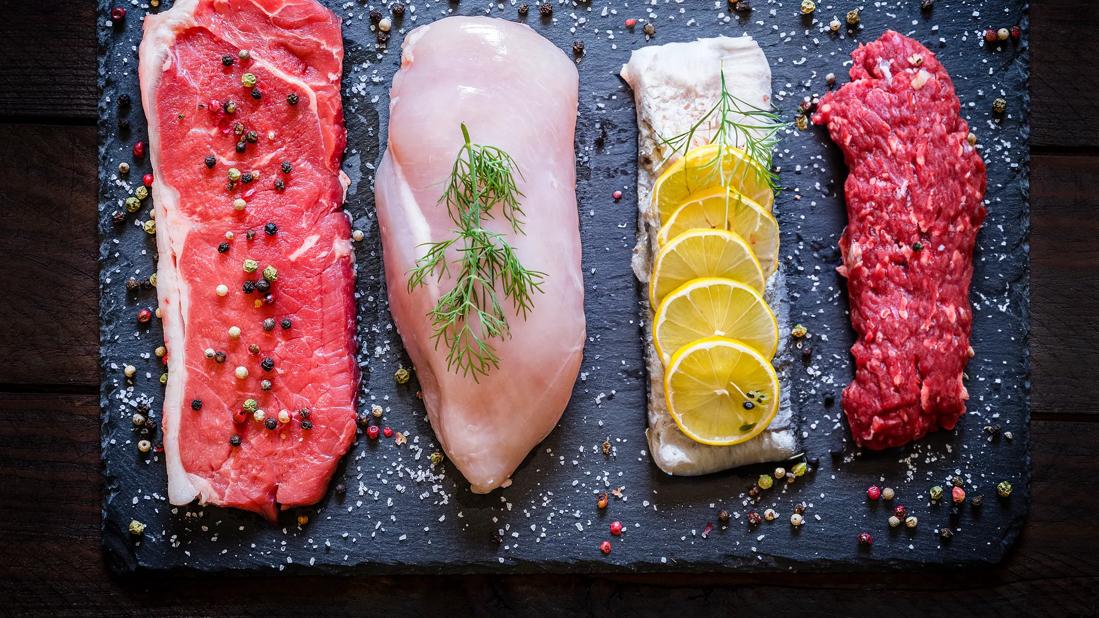This vital nutrient helps your brain and body in many ways — and most of us need more of it

You keep hearing about choline-rich foods on social media, but you aren’t sure what choline is. Do you think it’s:
Advertisement
Cleveland Clinic is a non-profit academic medical center. Advertising on our site helps support our mission. We do not endorse non-Cleveland Clinic products or services. Policy
A) A nutrient that helps your brain and liver.
B) The title of a classic country song.
C) The chemical found in swimming pools.
D) An illness you get from tainted water.
Give up? The correct answer is A.
While choline may rhyme with a familiar refrain from a classic country music tune or sound much like chlorine, it’s actually an essential nutrient. Choline helps your liver, brain and cells, and drives the way your body uses fats. It also plays a part in other important factors, like controlling your muscles, stimulating your memory and keeping your mood in check. Your body makes a little bit of it. The rest you get from choline-rich foods.
Researchers have studied what is now known as choline since the 1850s. But it hasn’t captured the spotlight like many other nutrients. (We’re looking at you, vitamins B and D, magnesium and calcium.) Choline wasn’t officially recognized as an essential nutrient until 1998, but it is finally landing the recognition it deserves. The problem is, you’re probably not getting enough of it. Research shows most people don’t.
“Our body produces some choline so it’s rare to be in a state of total deficiency,” says registered dietitian Julia Zumpano, RD, LD. “But we often don’t get enough of it naturally through high-choline foods.”
Advertisement
Choline plays a role in methylation, the chemical process in DNA that drives the way our cells read and use genetic information daily. Methylation also plays a role in detoxification. Research has shown that close to 50% of people may have genes that increase the amount of methyl they need from their diets. This increased need can make them deficient in nutrients that contribute to methylation, like choline.
While choline doesn’t typically take center stage in the world of nutrients, it works hard in your body every day by:
It does all of this through something called methylation. This is your body’s way of telling each molecule what to do and how to do it. Methylation handles how genes are turned into proteins so your cells can grow.
Choline helps keep methylation running smoothly. One example of this is heart health. During methylation, choline helps limit levels of an amino acid called homocysteine, which can contribute to heart disease and strokes.
While your liver makes a small amount of choline, you get most of this nutrient from food. But the typical U.S. diet doesn’t include enough choline food sources — at least not enough to meet the recommended daily intake.
So, how much is that? It depends on your sex recorded at birth, your age and whether you’re pregnant or breastfeeding. Recommended daily allowances for choline in milligrams are:
| Age and life stage | Recommended amount (milligrams) |
|---|---|
| 0–6 months | 125 mg |
| 7–12 months | 150 mg |
| 1–3 years | 200 mg |
| 4–8 years | 250 mg |
| Females 14–18 years | 400 mg |
| Males 14+ years | 550 mg |
| Females 19+ years | 425 mg |
| Females who are pregnant | 450 mg |
| Females who are lactating | 550 mg |
| Age and life stage | |
| 0–6 months | |
| Recommended amount (milligrams) | |
| 125 mg | |
| 7–12 months | |
| Recommended amount (milligrams) | |
| 150 mg | |
| 1–3 years | |
| Recommended amount (milligrams) | |
| 200 mg | |
| 4–8 years | |
| Recommended amount (milligrams) | |
| 250 mg | |
| Females 14–18 years | |
| Recommended amount (milligrams) | |
| 400 mg | |
| Males 14+ years | |
| Recommended amount (milligrams) | |
| 550 mg | |
| Females 19+ years | |
| Recommended amount (milligrams) | |
| 425 mg | |
| Females who are pregnant | |
| Recommended amount (milligrams) | |
| 450 mg | |
| Females who are lactating | |
| Recommended amount (milligrams) | |
| 550 mg |
Source: National Institutes of Health
A choline deficiency can make you feel sluggish, restless or anxious. This deficiency can cause:
But even if you’re low on choline, having a deficiency is rare if you’re healthy and aren’t pregnant. Women who are pregnant have the highest risk of complications from a deficiency. Too little choline during pregnancy raises the risk of brain and spinal cord problems during fetal development.
Research shows that eating choline-rich foods is the first line of defense against a deficiency. Where do you find those? Happily, choline is in all sorts of everyday foods.
Several kinds of meat and fish are in the Top 10 foods with choline, including organ meats. But how often do you eat chicken liver or beef liver?
If you live in the U.S., the answer’s probably rarely — or never. While these meats are popular globally, they aren’t as common in the typical U.S. diet. The thing is, Zumpano says, they’re the leading choline sources. After all, the liver helps make choline.
Advertisement
“Liver is one of the highest sources of all nutrients, including choline. But it’s just not a common food these days,” she notes. “It’s worth considering adding beef or chicken liver to your plate.”Three ounces of chicken liver has roughly 246 milligrams of choline. The same size serving of beef liver has around 356 mg.
“We’re definitely doing ourselves a disservice by not eating it,” Zumpano adds. “It’s so loaded with nutrients.”
If organ meats aren’t your thing, you can try other meats and fish, like 3 ounces of:
These options aren’t nearly as high in choline as liver. But they can still move the needle when it comes to adding this nutrient to your diet.
If you’re looking for more foods high in choline but don’t eat meat, you can’t go wrong by eating eggs. They’re second to liver, delivering 147 mg (27% of DV) of choline in one large hardboiled egg. And ignore the fact eggs often get a bad rap, Zumpano says.
“Our recommendations on eggs have evolved over recent years. They’re a great source of protein and many other nutrients,” she says. “Most of the nutrition, including choline, is in the yolk, so you want to eat the whole egg.”
Advertisement
But what about eggs (particularly the yolks) and cholesterol? For most people, the nutritional benefits are worth eating eggs in moderation. Zumpano says that dietitians recommend an average of an egg a day. If you have existing heart or coronary disease or uncontrolled cholesterol, you’ll want to eat only four yolks a week. Egg whites are unlimited, though, so don’t be shy with your egg intake.
But eggs aren’t the only source of choline in the dairy case. You can also find choline in many other dairy products like:
Mom was right when she told you to eat your veggies. Getting a boost of choline is one of them. Cruciferous veggies, lima beans and potatoes all help lift flagging choline levels. Mushrooms are another great choice. When it comes to veggies and mushrooms, your best bets for choline are:
Advertisement
Fruits tend to have less choline than their vegetable counterparts. But you can’t go wrong with eating fruit. Avocados, berries, tangerines, apples and kiwi are just a few that can give you a choline boost.
Soybeans, including the familiar green edamame, pack a powerful choline punch. A half cup of roasted soybeans delivers roughly 107 mg of choline or 21% of your DV. But other legumes like chickpeas, lentils and kidney beans will do you good, too. A handful of nuts can help as well. Almonds are the best nut to reach for when it comes to choline. One ounce provides about 15 mg of choline or 3% of DV.
You’ll also find choline in many whole grains, including:
Not everyone needs choline supplements. Your first move starts with eating more foods high in choline. But Zumpano says that there are times when taking one can be helpful.
“If you’re a vegetarian or vegan, you aren’t consuming meat or eggs, then you may not be able to get enough choline through plant-based sources. That’s when you may want to consider a supplement,” she notes.
Zumpano says food allergies can be another reason. Women who are postmenopausal, pregnant or breastfeeding may also benefit from a supplement. So might people with memory problems — to name just a few conditions and factors.
Your body absorbs some types of choline supplements better than others. This is known as bioavailability. It means your body will use the supplement to its best advantage rather than turning it into waste. Two of the most absorbent types of choline are Alpha-GPC and CDP-choline (citicoline).
No matter the reason you feel you may need to take a choline supplement, It’s important to talk to your healthcare provider before starting. They can help you find the best supplement — and dosage — for your needs. And they’ll make sure it doesn’t interfere with other medications you take.
Eating good, nutritious foods does more than boost your choline levels. Whole grains, protein-rich eggs and meat, beans, nuts, fruits and vegetables play an important role in your everyday health.
“It’s important to learn how it all works and how crucial good food is to preventing disease,” Zumpano says. “Choline plays a big part in how your body works, but all nutrients are essential in our bodies. And going beyond meeting the minimum for any of these with the foods you eat will help you feel better and will help your body function at its best.”
Learn more about our editorial process.
Advertisement

With a focus on internal cues for hunger and fullness, this eating style may revolutionize your relationship with food

Review the ingredients, watch for sugar and fat, and choose one with the right amount of protein for your needs

A typical recommended balanced diet is half fruits and veggies, a quarter protein and a quarter grains

Foods high in protein, fiber and water can help keep hunger at bay

This quirky food trend is harmless, as long as you’re getting enough protein, fiber and healthy fats

Wrapped or sandwiched, try to choose fillings and condiments that are minimally processed, low in saturated fat and high in fiber

Set yourself up for success by carefully choosing your recipes, storage containers and prepping day

These breaks may have some benefits — but they promote an unhealthy attitude toward food

The best parenting style balances enforcing rules and showing plenty of love

Tips include cutting back on sugar, focusing on exercise and managing stress

It can be harder to let go when you’ve invested time, energy and emotions — but it might be the healthier choice long term